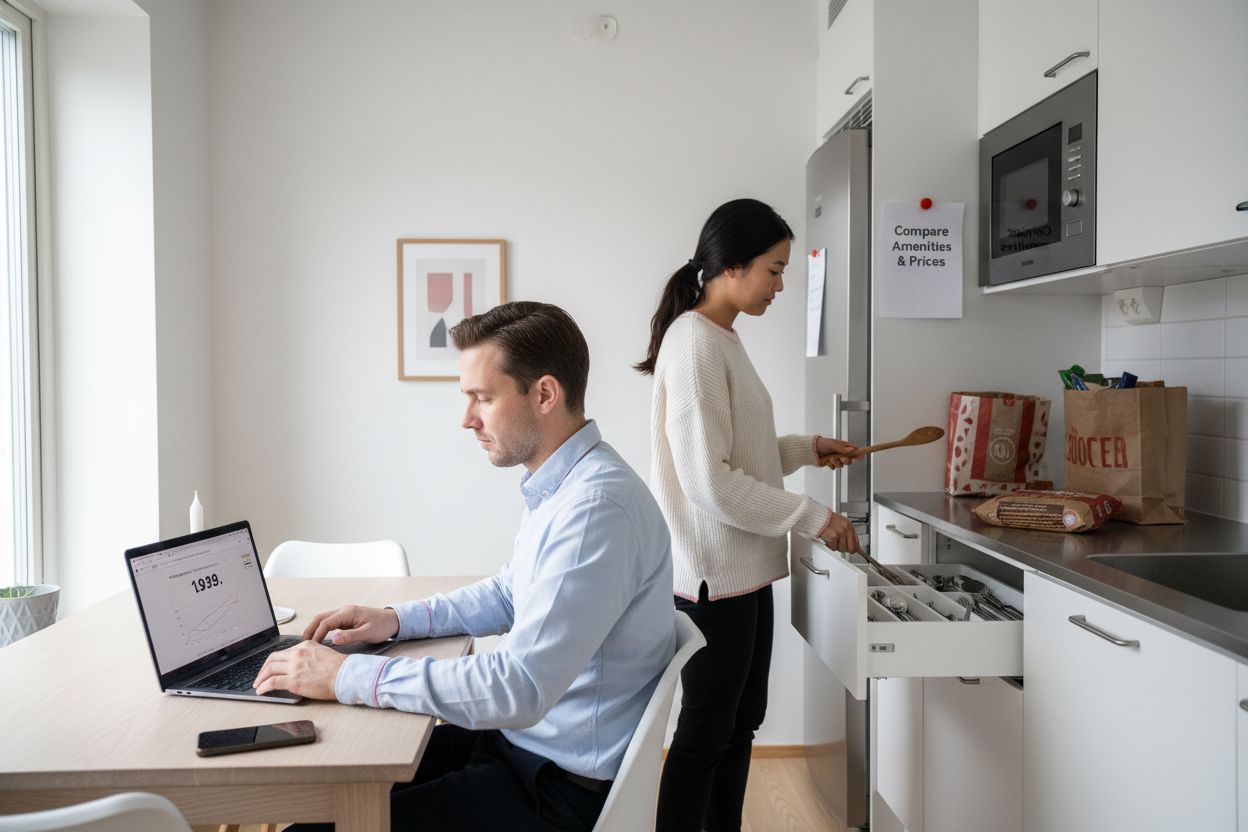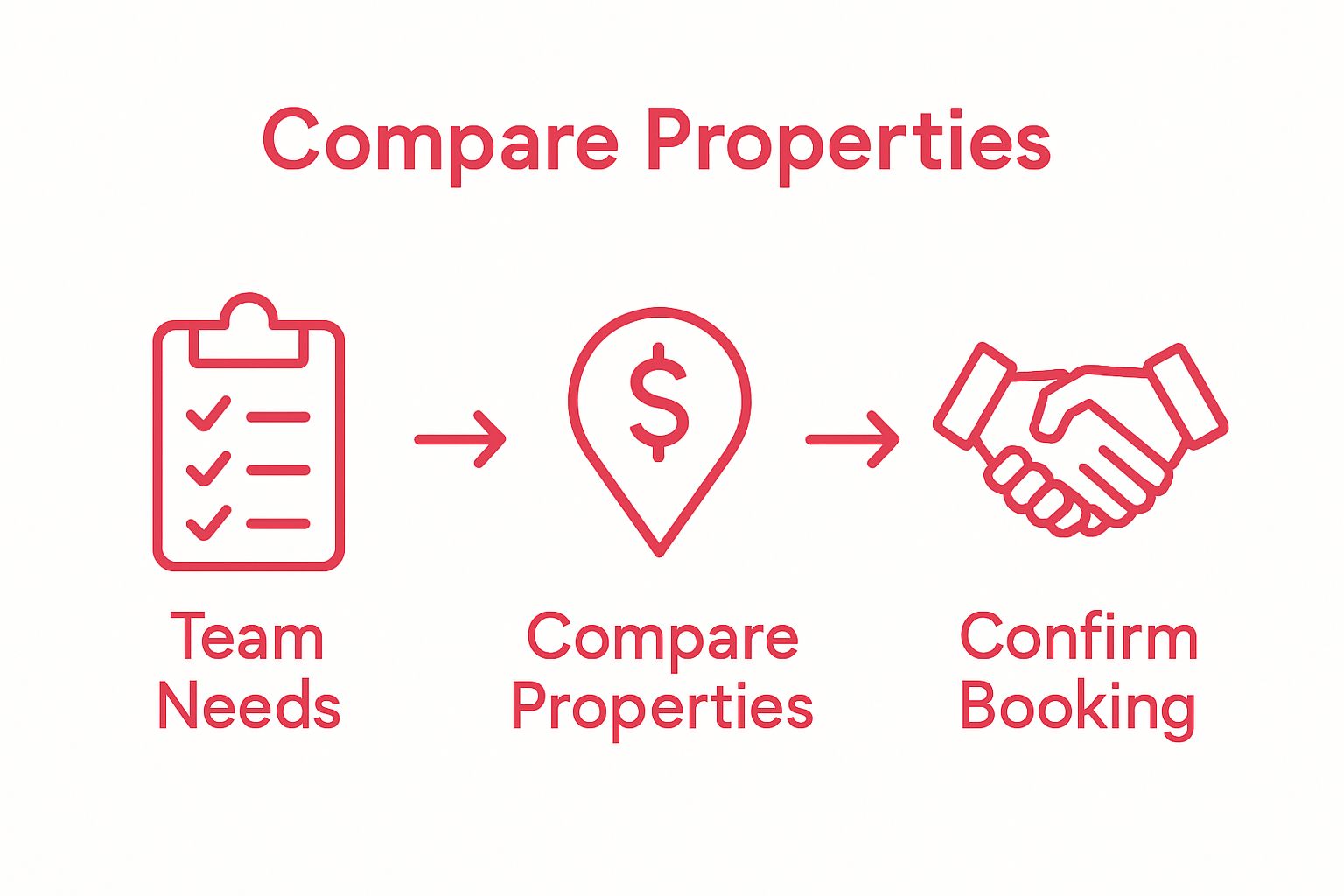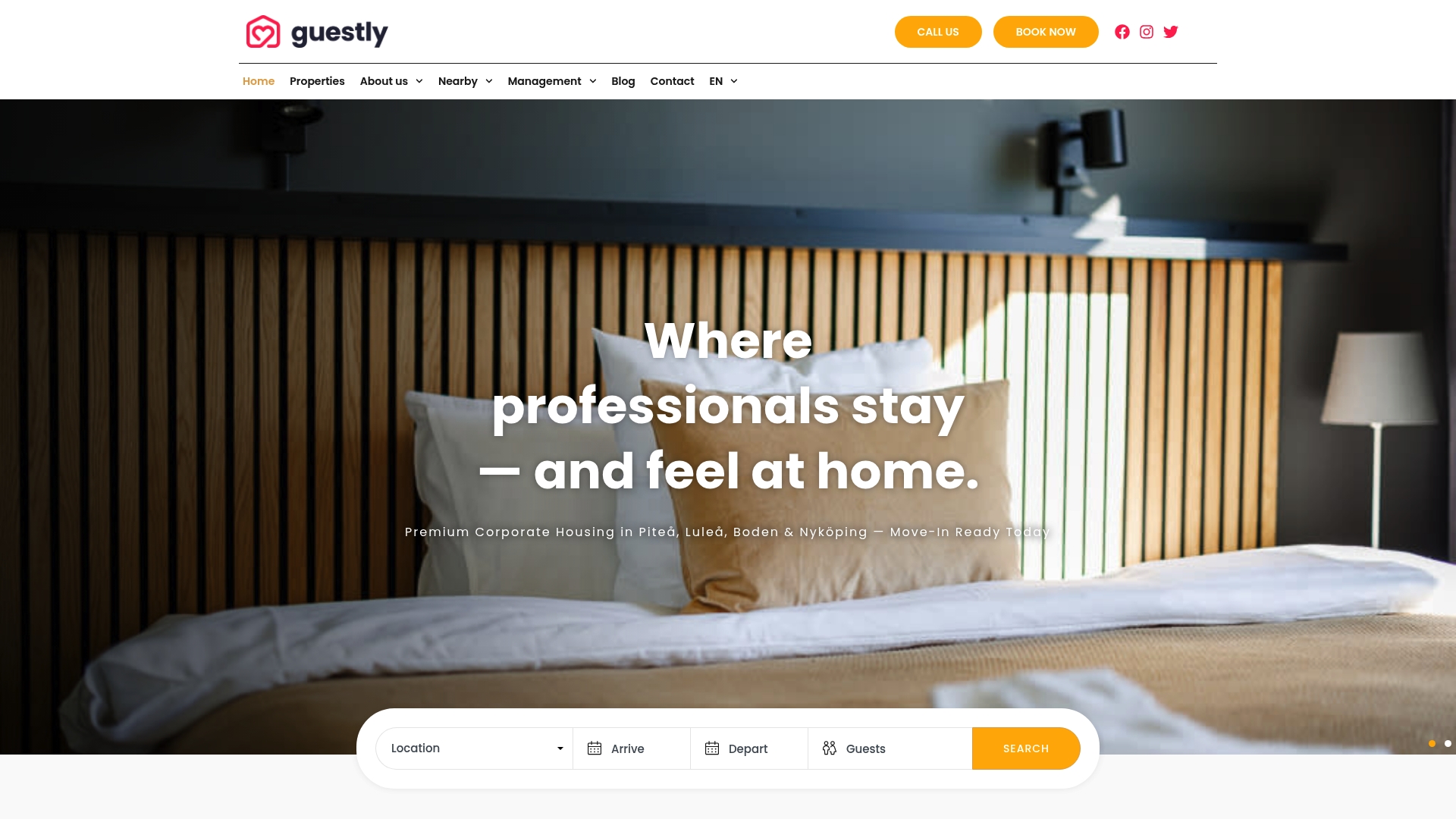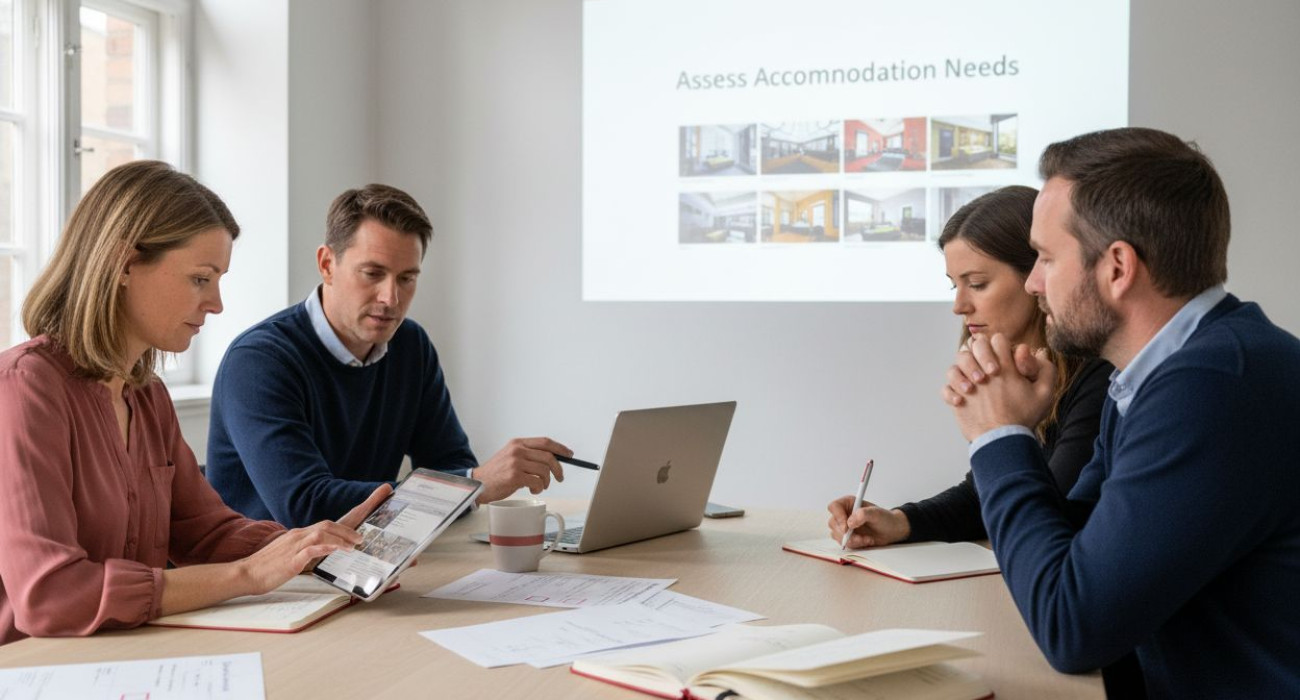Securing the right corporate accommodation can make or break your team’s productivity on assignment. Professional roles significantly influence accommodation preferences, so overlooking this can lead to costly mismatches and discomfort. But most managers get caught up in just booking rooms without realising the true driver of a successful stay is matching every detail to your team’s exact needs.
Table of Contents
- Step 1: Assess Accommodation Needs For Your Team
- Step 2: Research Available Properties In Piteå, Luleå, Boden, And Nyköping
- Step 3: Compare Amenities And Prices Of Shortlisted Properties
- Step 4: Communicate With Property Owners For Booking
- Step 5: Confirm Reservations And Payment Details
- Step 6: Verify Accommodation Before Employee Arrival
Quick Summary
| Key Point | Explanation |
|---|---|
| 1. Assess team accommodation needs | Understand team size, roles, and preferences to create an effective living and working environment. |
| 2. Research properties strategically | Identify locations close to project sites to improve productivity and operational efficiency. |
| 3. Compare amenities and costs thoroughly | Use a comparison matrix considering all associated costs and essential features for informed decision-making. |
| 4. Communicate clearly with property owners | Articulate your team’s requirements and expectations to facilitate a strong professional relationship. |
| 5. Verify accommodation before arrival | Perform pre-arrival checks on property amenities and technical facilities to ensure readiness for your team. |
Step 1: Assess accommodation needs for your team
Successful corporate accommodation begins with a precise understanding of your team’s unique requirements. This initial assessment is crucial for creating a comfortable and productive staying environment that supports your organisation’s operational goals.
Start by conducting a comprehensive team profile analysis. This means gathering detailed information about your team members who will be travelling. Consider factors such as team size, duration of stay, professional roles, individual preferences, and specific work requirements. Some professionals might need quiet workspaces for concentrated tasks, while others may require proximity to project sites or collaborative meeting areas.
Pay special attention to the technical and personal needs that distinguish your team’s accommodation requirements. Professional roles significantly influence accommodation preferences. An engineering team might prioritize high-speed internet and dedicated workspace, whereas a consulting group might need flexible living arrangements with multiple communication zones. Medical teams or research professionals could require specific proximity to research facilities or hospitals.
Physical requirements are equally important. Consider accessibility needs, potential mobility limitations, dietary restrictions, and cultural preferences that could impact accommodation selection. For instance, teams with international members might need kitchens that support specific cooking requirements or proximity to cultural amenities.
Document these requirements meticulously. Create a comprehensive accommodation brief that outlines:
- Total number of team members
- Required stay duration
- Specific professional workspace needs
- Accessibility requirements
- Dietary or cultural accommodation preferences
Through this systematic approach, you transform accommodation from a mere logistical task into a strategic support mechanism for your team’s performance. By understanding and anticipating their needs, you create an environment that minimises disruptions and maximises productivity.
For further insights into selecting the right corporate accommodation, read our comprehensive guide on executive housing selection.
Step 2: Research available properties in Piteå, Luleå, Boden, and Nyköping
Researching corporate accommodation in Northern Sweden requires a strategic and methodical approach. Your goal is to identify properties that not only meet your technical requirements but also provide an optimal environment for professional performance.
Begin by mapping out the specific geographical constraints of your team’s work locations. Understanding the precise proximity requirements to project sites, research facilities, or client locations will help narrow your property search. Location is more than just a point on a map – it directly influences team productivity and daily operational efficiency.
Utilise multiple research channels to compile your property options. Professional networks, corporate relocation services, and specialised accommodation platforms can provide comprehensive insights. Digital platforms offer detailed property specifications, but local recommendations from professional contacts in Piteå, Luleå, Boden, and Nyköping can reveal nuanced details that online listings might not capture.
Evaluate properties through a multi-dimensional lens. Beyond basic amenities, consider technological infrastructure, workspace configurations, privacy levels, and potential for collaborative interactions. Some properties might offer integrated work zones, high-speed internet connectivity, and flexible living arrangements that support different working styles.
Critical verification points for property selection include:
- Reliable high-speed internet connectivity
- Dedicated workspace or study areas
- Proximity to essential professional and personal services
- Flexible room configurations
- Security and access control systems
Pay special attention to the unique characteristics of each city. Luleå and Boden, for instance, have distinct industrial and technological landscapes that might influence accommodation requirements. Nyköping and Piteå offer different environmental contexts that could impact team dynamics and individual comfort.
For deeper insights into navigating corporate stays in this region, explore our comprehensive guide about relocating to Luleå, which offers valuable context for corporate accommodation strategies in Northern Sweden.
Step 3: Compare amenities and prices of shortlisted properties
Comparing corporate accommodation requires a systematic approach that balances financial considerations with functional requirements. This step transforms your property research into actionable decision making, ensuring your team receives optimal living and working conditions.
Financial transparency becomes paramount during this comparison stage. Create a standardised comparison matrix that goes beyond simple price points. Consider total cost of occupancy, which includes not just rental fees but additional expenses like internet connectivity, utility charges, cleaning services, and potential workspace setup costs. Some properties might appear costlier initially but offer integrated services that ultimately provide better overall value.
Examine each property’s amenities through a professional lens. Technical infrastructure matters significantly for corporate stays. Assess internet bandwidth, workspace configurations, meeting room availability, printing facilities, and communication zones. A property with robust technological support can dramatically enhance team productivity, potentially offsetting slightly higher rental costs.
Consider the nuanced differences between properties in Piteå, Luleå, Boden, and Nyköping. Each city presents unique accommodation characteristics influenced by local industrial landscapes and technological ecosystems. A property’s location within these cities can substantially impact its value proposition for corporate teams.
Key comparative criteria should include:
- Total monthly cost including all ancillary charges
- Internet speed and technological infrastructure
- Workspace flexibility and configuration
- Proximity to work sites and essential services
- Security and access management systems
Utilise digital tools and spreadsheets to create a comprehensive comparison. Assign weighted scores to different amenities based on your team’s specific requirements. This approach transforms subjective preferences into objective, measurable criteria.

Pay special attention to contractual flexibility. Some properties offer more adaptable terms that can be crucial for corporate teams with potentially changing project timelines. Negotiate potential discounts for longer-term stays or group bookings.

For additional guidance on selecting the perfect serviced accommodation, explore our detailed apartment selection guide, which provides deeper insights into making informed corporate housing decisions.
According to European consumer guidelines, always verify what specific amenities are included in the quoted price to avoid unexpected additional expenses.
Step 4: Communicate with property owners for booking
Effective communication with property owners transforms your accommodation search from a transactional process into a strategic partnership. This step requires precision, professionalism, and a clear articulation of your team’s specific requirements.
Professional communication begins with a comprehensive initial inquiry. Prepare a detailed brief that encapsulates your team’s accommodation needs, including precise duration of stay, total number of occupants, specific workspace requirements, and any unique operational considerations. Your communication should demonstrate that you are not just seeking a space, but establishing a professional relationship.
Initiate contact through formal channels, preferably via email, which provides a documented trail of communication. Craft a concise yet comprehensive message that outlines your requirements, potential stay duration, and specific expectations. Be transparent about your team’s professional context – whether you are a research group, consulting team, or project-based organisation. This specificity helps property owners understand the context of your accommodation needs.
Prepare a set of critical questions to clarify potential ambiguities. Inquire about internet bandwidth, workspace configurations, cleaning protocols, access management, and potential flexibility in stay arrangements. Professional property owners appreciate precise, structured communication that demonstrates your serious intent and operational requirements.
Key communication elements should include:
- Exact duration of proposed stay
- Total number of team members
- Specific technological and workspace requirements
- Potential flexibility in booking terms
- Budget parameters
During negotiations, maintain a collaborative tone. Seek mutually beneficial arrangements that provide value to both your team and the property owner. Some owners might offer discounted rates for longer stays or be willing to customize spaces to support professional workflows.
Document all communication meticulously. Save email threads, note verbal discussions, and maintain a clear record of discussions and agreements. This documentation protects both parties and provides a clear reference point for future interactions.
For comprehensive insights into property owner interactions, explore our guide on property management strategies, which offers additional perspectives on professional accommodation negotiations.
Remember that successful booking is not just about securing a space, but establishing a professional relationship that supports your team’s operational objectives.
Step 5: Confirm reservations and payment details
Confirming reservations and payment details represents the critical junction where your comprehensive accommodation planning transforms into a concrete commitment. This step demands meticulous attention to detail and strategic financial management.
Precision in documentation becomes your primary objective. Request a comprehensive written contract that explicitly outlines all reservation parameters. This document should comprehensively detail rental terms, payment schedules, included amenities, access protocols, and any specific agreements negotiated during earlier communications. Carefully review each clause to ensure alignment with your organisational requirements and potential contingency scenarios.
Financial transactions require a structured approach. Verify acceptable payment methods with the property owner, ensuring compatibility with your organisation’s procurement processes. Some corporate entities have specific protocols regarding international payments, expense tracking, and reimbursement mechanisms. Coordinate with your financial department to establish a smooth payment workflow that maintains fiscal accountability.
Prepare a detailed internal tracking mechanism for the reservation. This involves creating a comprehensive record that includes:
- Full property contact information
- Reservation confirmation numbers
- Total financial commitment
- Payment schedule and method
- Specific terms and conditions
- Cancellation and modification policies
Consider potential risk mitigation strategies. Discuss and document flexible modification options in case of unexpected project changes or team restructuring. Professional property owners often appreciate transparent communication about potential future adjustments to booking arrangements.
Technological integration can streamline this process significantly. Utilise secure digital platforms that provide real-time documentation, encrypted communication channels, and transparent transaction tracking. These tools not only simplify administrative processes but also provide robust audit trails for financial compliance.
Carefully examine all supplementary charges beyond base rental rates. Request a comprehensive breakdown of potential additional expenses such as utility charges, cleaning services, or technological infrastructure support. Transparency in financial expectations prevents future misunderstandings.
For additional insights into professional booking procedures, explore our comprehensive check-in guidelines, which offer valuable perspectives on finalising accommodation arrangements.
According to European consumer guidelines, ensure all payments are made through secure, traceable methods and maintain thorough documentation for compliance purposes.
Step 6: Verify accommodation before employee arrival
Verifying accommodation before employee arrival represents a critical quality assurance process that mitigates potential risks and ensures a seamless professional experience. This step transforms your reservation from a theoretical arrangement into a confirmed, functional workspace for your team.
Comprehensive pre-arrival verification requires a systematic and thorough approach. Initiate the process by requesting a detailed virtual tour or comprehensive photographic documentation of the entire property. Modern communication technologies like video conferencing platforms enable real-time property inspections, allowing you to assess workspace configurations, technological infrastructure, and overall living environments with remarkable precision.
Conduct a meticulous technical infrastructure assessment. Verify internet connectivity speeds, workspace electrical outlets, meeting room configurations, and communication zone capabilities. Professional teams require robust technological environments that support seamless work processes. Test potential connectivity through speed measurement tools and request empirical data about bandwidth consistency from property owners.
Key verification points should encompass:
- Internet connectivity speed and reliability
- Workspace electrical and technological infrastructure
- Kitchen and personal amenities functionality
- Security access systems
- Potential noise levels and work environment quality
Engage directly with property management to clarify specific operational protocols. Discuss access management, key collection procedures, emergency contact information, and any site-specific guidelines that might impact your team’s arrival and settling-in process. This proactive communication eliminates potential friction points and demonstrates professional diligence.
The following checklist summarises the key points to verify before your team arrives at the accommodation, ensuring that all essential requirements are met for a smooth transition.
| Verification Point | What to Check For |
|---|---|
| Internet connectivity speed and reliability | Consistent, high-speed connection suitable for work |
| Workspace electrical and technological infrastructure | Adequate power outlets, stable equipment, reliable Wi-Fi |
| Kitchen and personal amenities functionality | Working appliances, suitable facilities for dietary needs |
| Security access systems | Secure entry, proper key or code protocols |
| Potential noise levels and work environment quality | Quiet surroundings, conducive to concentration |
| Documentation of inspection | Photographs, virtual tour, and standardised checklist |
| Access management and arrival procedures | Clear key collection, emergency contacts, house rules |
Document all verification findings meticulously. Create a standardised checklist that captures every aspect of the property’s readiness. This documentation serves multiple purposes: it provides a clear reference point, establishes accountability, and creates a formal record of the property’s condition before team arrival.
Consider dispatching a preliminary representative or local contact to conduct a physical pre-arrival inspection if feasible. This additional verification layer provides tactile insights that virtual assessments might miss. The goal is not just confirming availability, but ensuring an environment conducive to professional performance.
For additional guidance on property preparation, explore our essential property handover checklist, which offers comprehensive insights into professional accommodation readiness.
According to European Commission recommendations, pre-arrival property checks are crucial for confirming suitability, safety standards, and complete alignment with promised amenities.
Turn Corporate Accommodation Complexity into Confidence with Guestly Homes
Struggling to secure reliable corporate accommodation for your team? The process described in “Navigating Corporate Accommodation: Secure the Best Stays” reveals how much is at stake. From uncertain property standards to time-consuming negotiations and a constant risk of missed details, each step introduces potential stress and disruption. Your priorities—seamless bookings, clear communication, tailored spaces, and guaranteed standards—demand more than just a rental listing or a hopeful email chain. You deserve a partner who anticipates every requirement and delivers support at every stage.

Stop settling for compromise or distraction during your team’s extended stays. Choose Guestly Homes to experience a fully managed, frictionless service crafted for corporate bookers and property owners alike. We provide high-standard serviced apartments and villas across Sweden, with no drama and no delays, so your team can focus on what matters. Discover how we deliver precision, consistency, and the peace of mind missing from ordinary stays—visit our home page to explore our approach. Ready for immediate solutions? Learn more about our tailored accommodation for professionals in this detailed serviced apartment guide or discover executive housing options in our executive housing selection article. Book with Guestly now and turn every stay into a strategic advantage.
Frequently Asked Questions
How can I assess my team’s accommodation needs effectively?
To assess your team’s accommodation needs, gather detailed information about team size, duration of stay, and specific workspace requirements. Create a comprehensive accommodation brief that includes these details, ensuring you cover all personal and professional preferences.
What should I include in my accommodation brief for property owners?
Your accommodation brief should detail the total number of team members, required stay duration, workspace needs, accessibility requirements, and any dietary or cultural preferences. Compile this document to provide a clear overview of your expectations when communicating with property owners.
How do I research and shortlist suitable accommodation properties?
Begin by mapping out the specific locations relevant to your team’s work. Use multiple research channels like corporate relocation services and digital platforms to gather property options that meet both your technical and geographical requirements.
What criteria should I use to compare different accommodation properties?
When comparing properties, consider key factors like total cost, internet speed, workspace configurations, and proximity to relevant sites. Create a comparison matrix that weighs these aspects based on your team’s specific needs to facilitate an informed decision.
How should I communicate my accommodation requirements to property owners?
Initiate contact with property owners by sending a structured inquiry that outlines your team’s duration of stay, number of occupants, and specific workspace needs. Prepare critical questions about amenities and potential flexibility to ensure all essential details are discussed clearly.
What steps should I take to verify accommodation before my team arrives?
To verify accommodation, request virtual tours or photographic documentation of the property, focusing on technical infrastructure and workspace configurations. Compile a checklist to confirm that everything meets your team’s requirements before arrival.
Recommended
- The Ultimate Guide to Corporate Housing Furnished Apartments 2025 – Guestly Homes
- The Ultimate Guide to Corporate Serviced Accommodation 2025 – Guestly Homes
- The Ultimate Guide to Corporate Homes for Professionals 2025 – Guestly Homes
- What is a Corporate Lease Apartment? Understanding the Concept – Guestly Homes



